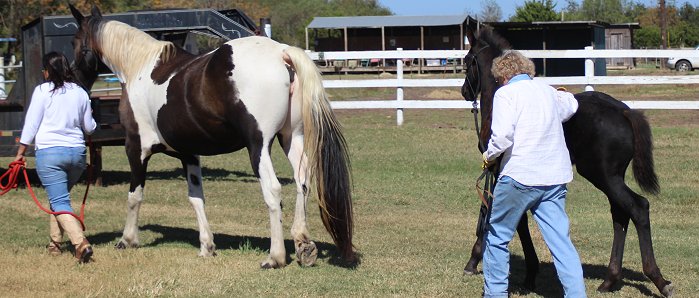 A rancher’s work is never done. With all intentions of working with little Kristull Abaddon as prescribed in How to Train the 3 week old Foal, ranch work came first. Fences needed fixing. Pastures needed mowing. Mow Decks and Seed Hoppers needed repair, and a myriad of other day-to-day jobs always nag. It happens to the best of us, and the Kristull Ranch is no exception.
A rancher’s work is never done. With all intentions of working with little Kristull Abaddon as prescribed in How to Train the 3 week old Foal, ranch work came first. Fences needed fixing. Pastures needed mowing. Mow Decks and Seed Hoppers needed repair, and a myriad of other day-to-day jobs always nag. It happens to the best of us, and the Kristull Ranch is no exception.
We must now pay the piper for our inability to spend as much time as is needed with our new Friesian baby. Abaddon is now 10 weeks old. He is not wild, but he has learned that in the pasture he can stay just one step away from your hand. He simply saunters around his Momma’s fanny, out of reach.
He needs a little more de-sensitizing to our touch and to control. But he is MUCH bigger and stronger than he was just two months ago. He is too young to do round-penning work to teach him to stand still when we approach and how to take his halter without a fight. He is too old and too wise to use the pasture loop.
It’s beautiful weather: 85 degrees and dry. The October rains (so infamous for the devastating Halloween flooding 3 years ago that killed dozens of horses) have not materialized. While it is delaying the planting of our winter rye pastures, it is presenting us with an opportunity to catch up a little without dying of a heat stroke.
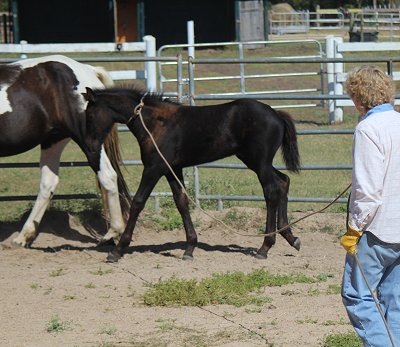 We took both Abaddon and his mother to the round pen (mother on a lead and baby frisking along side, loose). With us we took a baby halter, a lead rope and a nice, stiff lariat.
We took both Abaddon and his mother to the round pen (mother on a lead and baby frisking along side, loose). With us we took a baby halter, a lead rope and a nice, stiff lariat.
The goal is to give him the confidence of his mother’s presence while he learns a gentle lesson in control.
As he moved from side to side to avoid our hands, we gently dropped the loop of the lariat over his head. Then allowed it to tighten momentarily as he trotted to the end. He dragged the rope for some time with intermittent tugs and slight resistance from us. We wanted the smallest amount of fighting possible. This is not like calf roping. We did not THROW the rope, and we did not want him to roll end over end into a heap.
A lariat is your friend if you know how to use it. Because it is stiff, it is easy to make a BIG loop that goes over his head without spooking him. Because it is stiff, it also releases fairly easily, allowing him to feel the difference between a tight rope and loose one.
He obviously didn’t like the tight collar. After several minutes of trotting around and small tugs, I started adding a little more pressure. As he argued his way to his mother’s side, I made sure that the loop loosened when he stopped moving – every time. This is critical. He is having his first understanding of controlling his own pressure. If he pulls, the loop tightens. If he stops and stands still, the loop loosens. (see Release Training)
The secret to keeping this whole experience “low key” is to HELP him find the comfort zone: Quiet standing, no pressure.
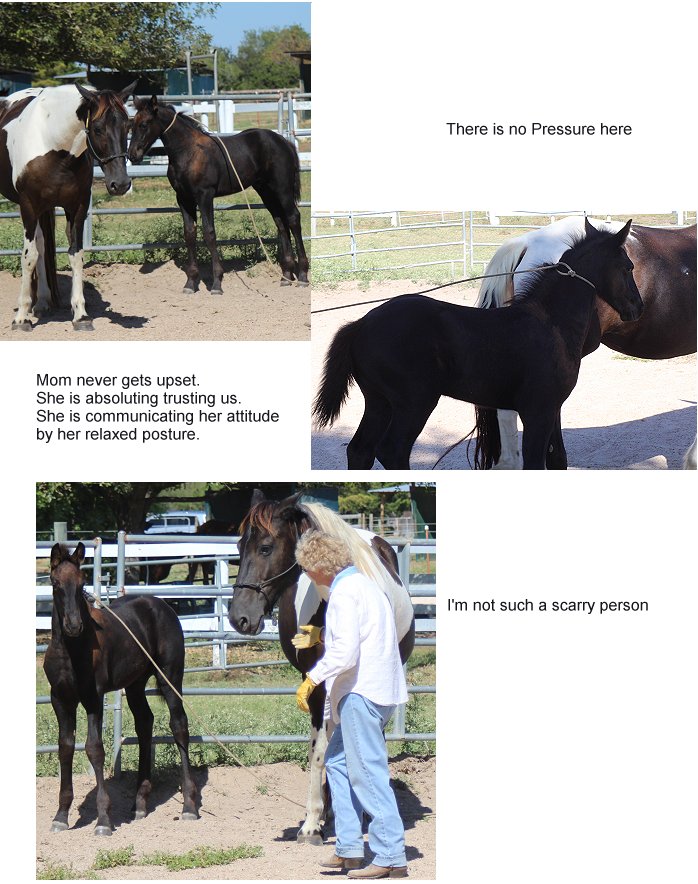 In the old days, a colt would fight until he was exhausted, then find out that standing was better than fighting. We have a little better understanding of how to keep the stress down. He was only restrained when he was near enough to his dam that he would instinctively move to her side and stop. Presto! Loose rope. (At first, he probably credited his mother with the save. But as he found other places further from her side to stop, he found the rope loose there as well.)
In the old days, a colt would fight until he was exhausted, then find out that standing was better than fighting. We have a little better understanding of how to keep the stress down. He was only restrained when he was near enough to his dam that he would instinctively move to her side and stop. Presto! Loose rope. (At first, he probably credited his mother with the save. But as he found other places further from her side to stop, he found the rope loose there as well.)
As he stood tight against his mother, we used two people to begin the touching techniques. (Unfortunately, we had no hands for the camera here). One person behind him began to firmly and pleasurably rub his fanny (blocking his backward escape at the same time). The front person began to touch then rub his face and head, preparing for the halter mount. We rubbed and pressed him up next to his mother, who stood stock still. He could feel her heart beat and he could feel Danielle’s heart beat on his rump as she leaned over and on him. “All is well.”
This is where his imprint training returned. Once touched, he relented and actually began to calm and enjoy the massage and rub. One try, two tries, and on the third round of rubbing the halter was fitted easily.
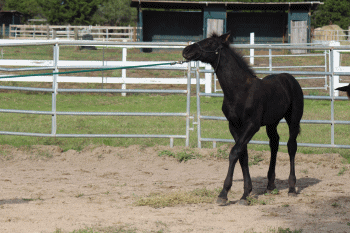 Now he was allowed to walk or trot around again dragging the rope but wearing the halter before the lead was attached and the lariat gently removed. A little time to follow his mother around the fence line getting a few tugs and restraints from the halter. Then more insistent restraint during which he pulled back and then relented. All pressure was released the moment he stopped pulling.
Now he was allowed to walk or trot around again dragging the rope but wearing the halter before the lead was attached and the lariat gently removed. A little time to follow his mother around the fence line getting a few tugs and restraints from the halter. Then more insistent restraint during which he pulled back and then relented. All pressure was released the moment he stopped pulling.
Because the halter is a rope halter, it has a very precise poll pressure if he tries to pull against it. It took no time at all for him to realize that giving INTO the pressure released it, and we were on our way.
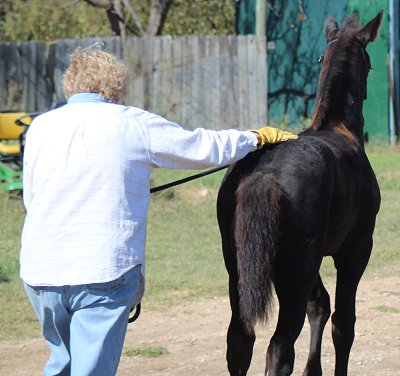 His lesson took about 30 minutes and he got very tired. But eventually, he went on a walk across the pasture wearing his halter and lead rope, following his mother with human hands guiding and touching him all the way.
His lesson took about 30 minutes and he got very tired. But eventually, he went on a walk across the pasture wearing his halter and lead rope, following his mother with human hands guiding and touching him all the way.
The next day, he voluntarily approached a small child in the pasture.
A week later he went to the round pen and repeated the lariat experience but calmed down much more quickly and really began to understand the halter pressures. Lots of pleasant rubbing and talking.
Every day since, he has approached anyone on foot in the pasture and been cajoled into face touching and body rubbing. His curiosity is a real benefit. When I walk to him, I am always carrying a lead rope and rope halter, dangling and swinging gently. He wants to investigate it, smell it, put it into his mouth. I drop it, drag it, gently toss it toward him, De-sensitizing him to its appearance and actions. Yesterday, I began twirling it, letting it rhythmically slap the ground on either side of him and in front of him. Steady as a statue.
We’re on our way to a manageable colt. A little later than we planned but successful none-the-less.
Horse training can be dangerous. Not all methods work on all horses. Instruction presented here is not meant to be prescriptive in nature, and Horse-Pros.com takes no responsibility for the welfare of any animal or person using our methods.
Please note that any advice given on horse-pros.com is neither veterinary nor prescriptive in nature but offered only as an introduction to this topic.
We need your help. We certainly don’t know everything. Please share your expertise and experiences. Comment on what is already written or Suggest a Category and Educate us about it. Grow Horse-Pros.comc
